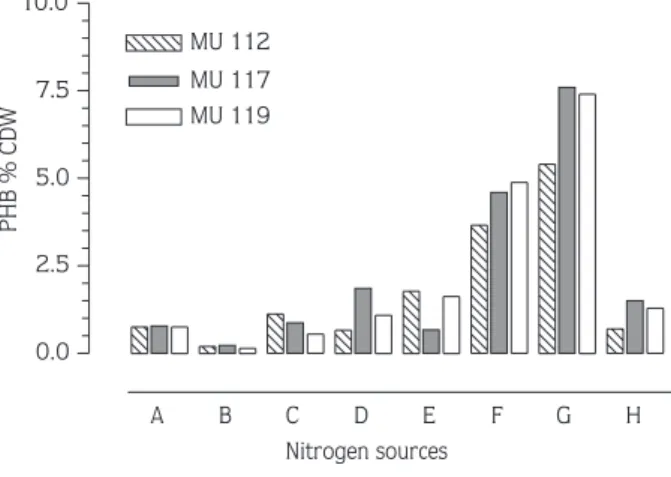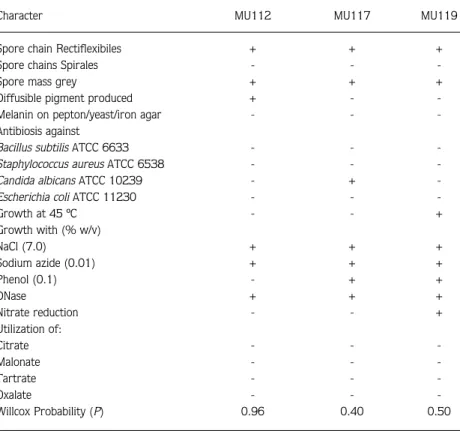Introduction
At least 75 different genera of bacteria have been known to accumulate poly-β-hydroxybutyric acid (PHB) as intracellular granules. This polymer is synthesized under limited culture conditions and is used as a carbon and energy reserve. PHB production has most commonly been studied on micro-organisms belonging to the genera Alcaligenes, Azotobacter, Bacillus and Pseudomonas (1).
Aerobic, Gram-positive bacteria belonging to the genera Rhodococcus, Nocardia and Streptomyces are widely distributed in nature. Members of these bacteria are also able to synthesize and accumulate PHB when cultivated on different carbon sources under nitrogen
limiting conditions (2). However, the occurrence and formation of PHB have not been investigated to a significant extent.
In the present study, we investigated the ability of some Streptomyces isolates to accumulate PHB under different nitrogen-limiting conditions.
Materials and Methods
Bacterial isolates, media and growth conditions: Cultures of soil Streptomyces used in this study were obtained from the culture collection of Mu¤la University (MU). For screening PHB production ability and other nitrogen-limited conditions, isolates were grown in 50 ml
Turk J Biol 26 (2002) 171-174 © TÜB‹TAK
171
Accumulation of Poly-
β
-Hydroxybutyrate in Streptomyces Species
During Growth with Different Nitrogen Sources
Aysel U⁄UR, Nurettin fiAH‹N
Mu¤la University, Faculty of Arts & Sciences, Department of Biology, TR-48187, Kötekli, Mu¤la - TURKEY Yavuz BEYATLI
Gazi University, Faculty of Arts & Science, Department of Biology, Ankara - TURKEY
Received: 24.01.2002
Abstract: The accumulation of poly-β-hydroxybutyric acid (PHB) in 27 Streptomyces isolates with different taxonomical properties was investigated. The amount of synthesized PHB was determined as crotonic acid by spectrophotometry. Eighty percent of the tested isolates accumulated PHB between 0.3 and 7.6% of dry mycelial weight. PHB was produced by a selectant of Streptomyces
isolates in media containing different nitrogen sources (KNO3, glycine, peptone, proteose peptone, L-asparagine, tryptone and malt
extract), each combined with 2 g/l glucose as the carbon source. The most effective PHB production was observed on glycine/glucose medium with a 7.6% dry mycelial weight. Nitrogen limiting conditions were inhibitory to Streptomyces growth, but stimulated PHB accumulation. Based on the morphological and biochemical test results, selected isolates were identified as Streptomyces halstedii (MU112), S. anulatus (MU117) and S. rochei (MU119).
Key Words: Poly-β-hydroxybutyric acid (PHB), Streptomyces, nitrogen sources
Farkl› Azot Kaynaklar› ile Büyüme S›ras›nda Streptomyces Türlerinde Poly-β-Hydroxybutyrat›n Birikimi
Özet: Farkl› taksonomik özelliklere sahip 27 Streptomyces izolat›nda Poly-β-hydroxybutyric asit (PHB) birikimi araflt›r›ld›. Sentezlenen PHB miktar› krotonik asit olarak spektrofotometre ile belirlendi. Denenen izolatlar›n %80’i PHB yi kuru miselyum
a¤›rl›¤›n›n %0.3-7.6’s› aras›nda akümüle etti. PHB, seçilmifl Streptomyces izolatlar› taraf›ndan, farkl› azot kaynaklar› (KNO3, glisin,
pepton, proteoz pepton, L-asparagin, tripton ve malt ekstrakt) ve karbon kayna¤› olarak da herbiri 2 g/l glukoz içeren besiyerlerinde üretildi. En etkili PHB üretimi kuru miselyum a¤›rl›¤›n›n %7.6‘s› ile glisin/glukoz ortam›nda gözlendi. Azotca s›n›rland›r›lm›fl flartlar Streptomyces geliflimini inhibe ederken, PHB akümülasyonunu teflvik etmifltir. Morfolojik ve biyokimyasal test sonuçlar›na göre seçilen izolatlar, Streptomyces halstedii (MU112), S. anulatus (MU117) ve S. rochei (MU119) olarak tan›mland›.
of nitrogen basal medium (3) in 250 ml Erlenmayer flasks. The medium was inoculated with 1 ml of activated homogeneous mycelial suspension and incubated at 30 °C in a rotary shaker (105 t/min) for 72 h. Growth was determined by measuring the dry weight of mycelial mass.
Experiments with nitrogen sources: Twenty-seven Streptomyces isolates were screened for PHB producing ability. For screening 2 g/l (NH4)2SO4 was used as the
nitrogen source. After this experiment, selected isolates were grown on different nitrogen sources to determine their production potential for PHB. Nitrogen basal medium was used as the main medium, but (NH4)2SO4
was replaced by other nitrogen sources. These compounds were KNO3, glycine, peptone, proteose
peptone, L-asparagine, tryptone and malt extract at 1 g/l concentration. All media were adjusted to pH 6.8. Cells were grown in a rotary shaker (105 t/min) at 30 °C and harvested after 72 h of incubation by centrifugation at 10,000 g for 10 min. Then they were washed twice with distilled water before lysis in Na-hypochloride.
Analysis of PHB: For extraction of PHB the dry mycelial mass was lysed in Na-hypochloride at 37 °C for 12 h. Then PHB was extracted by chloroform. The chloroform extract was evaporated to dryness, and converted to crotonic acid by treatment with concentrated sulphuric acid. Absorbance spectra were determined by scanning the samples between 220 and 300 nm with a Shimadzu UV/VIS 1601 spectrophotometer (4).
Characterization of the Streptomyces: All isolates were cultivated on glucose/yeast extract/malt extract agar (ISP 2). Some diagnostic characters of highly productive Streptomyces isolates were determined by following the directions given in the probabilistic identification matrix (3) and Bergey's Manual of Systematic Bacteriology (5). A Willcox probability (P) matrix was used to assign and identify the isolates where P scores of 0.8 and above indicated a positive identification (6).
Results and Discussion
A large proportion (80%) of the tested soil Streptomyces isolates was able to produce PHB as energy reserve material (Fig. 1). However, the actual amounts of PHB accumulation (percent of cell DW) were generally lower for the industrial applications than for the other bacterial groups, which are known to produce PHB.
Based on the screening data, the isolates MU112, MU117 and MU119, which represent different taxonomical groups, were selected for experiments with various nitrogen sources. The selected isolates were characterized by some morphological and physiological properties presented in the Table. According to the test results isolates MU112, MU117 and MU119 were identified as Streptomyces halstedii, S. anulatus and S. rochei respectively.
The accumulation of PHB varied with taxonomical properties of Streptomyces isolates and nitrogen type in the medium. The main characteristics of the PHB
Accumulation of Poly-β-Hydroxybutyrate in Streptomyces Species During Growth with Different Nitrogen Sources
172 200 225 250 275 300 0 1 2 3 Wavelength (nm) Absorbance A B C D E F G H 0.0 2.5 5.0 7.5 10.0 MU 112 MU 117 MU 119 Nitrogen sources PHB % CDW
Figure 2. PHB accumulation by some Streptomyces grown on
different nitrogen sources. A: (NH4)2SO4, B: Asparagine, C:
Malt extract, D: Peptone, E: Proteose peptone, F: Tryptone,
G: Glycine, H: KNO3.
Figure 1. UV spectra of PHB isolated from strain MU112. (lane
producing Streptomyces were the grey colour of mature sporulated aerial mycelium, rectiflexibiles type of sporophore and negative melanoid pigment production.
Maximum PHB content was found in MU117 when glycine (7.6%) or tryptone (4.6%) was used as the nitrogen source. The PHB content was much lower when asparagine and (NH4)2SO4 were used as the nitrogen
source. In a previous study, the PHB content of the less active strain of Rhizobium meliloti was reported to be high when grown on KNO3 and glycine as nitrogen
sources (7). PHB accumulations by selected Streptomyces isolates after cultivation on different nitrogen sources are shown in Figure 2. Nitrogen-limiting conditions were inhibitory to mycelial growth, but stimulated PHB production (Fig. 3).
The PHB producing efficiency of these isolates under different nitrogen stress conditions ranged from 0.3 to
7.6% of their dry mycelial weight. In earlier experiments, similar to our observations, researchers reported very low PHB formation by Streptomyces (8).
A. U⁄UR, N. fiAH‹N, Y. BEYATLI
173
Character MU112 MU117 MU119
Spore chain Rectiflexibiles + + +
Spore chains Spirales - -
-Spore mass grey + + +
Diffusible pigment produced + -
-Melanin on pepton/yeast/iron agar - -
-Antibiosis against
Bacillus subtilis ATCC 6633 - -
-Staphylococcus aureus ATCC 6538 - -
-Candida albicans ATCC 10239 - +
-Escherichia coli ATCC 11230 - -
-Growth at 45 ºC - - + Growth with (% w/v) NaCl (7.0) + + + Sodium azide (0.01) + + + Phenol (0.1) - + + DNase + + + Nitrate reduction - - + Utilization of: Citrate - - -Malonate - - -Tartrate - - -Oxalate - - -Willcox Probability (P) 0.96 0.40 0.50
Table. Some taxonomical properties of
selected PHB producing Streptomyces. 0 1 2 3 4 5 6
Nitrogen concentration (tryptone, g/l)
% PHB cell DW
0.5 1 2 3
Figure 3. Effect of nitrogen concentration on PHB production.
1. Anderson, A.J., Dawes, E.A. Occurrence, metabolism, metabolic
role and industrial uses of bacterial polyhydroxyalkanoates. Microbiol Rev., 54: 450-472, 1990.
2. Alvarez, H.M., Kalscheuer, R., Steinbüchel, A. Accumulation of
storage lipids in species of Rhodococcus and Nocardia and effect of inhibitors and polyethylene glycol. Fett-Lipid, 99: 7: 239-246, 1997.
Accumulation of Poly-β-Hydroxybutyrate in Streptomyces Species During Growth with Different Nitrogen Sources
174
3. Williams, S.T., Goodfellow, M., Wellington, E.M.H., Vickers, J.C.,
Alderson, G., Sneath, P.H.A., Sackin, M.J., Mortimer, A.M. A probability matrix for identification of some Streptomycetes. J. Gen. Microbiol., 129: 1815-1830, 1983.
4. Gerhardt, P., Murray, R.G.E., Wood, W.A., Krieg, N.R. Methods
for General and Molecular Bacteriology, Washington, DC., 1994 American Society for Microbiology, 628.
5. Williams, S.T., Goodfellow, M., Alderson, G. Genus Streptomyces
(Waksman & Hanrici 1943) 339AL. In Bergey's Manual of
Systematic Bacteriology, Edited by Williams, S.T., Sharpe, M.E., & Holt, J.G. vol. 4, Baltimore, 1989, Williams & Wilkins, pp. 2452-2492.
6. Willcox, W.R., Lapage, S.P., Bascomb, S., Curtis, M.A.
Identification of bacteria by computer: theory and programming. J. Gen. Microbiol., 77: 317-330, 1973.
7. Bonartseva, G.A., Myshkina, V.L., Zagreba, E.D. Poly-β
-hydroxybutyrate content in cells of various Rhizobium species during growth with different carbon and nitrogen sources. Microbiol., 63: 1, 45-48, 1994.
8. Kannan, L.V., Rehacak, Z. Formation of Poly-β-hydroxybutyrate by

